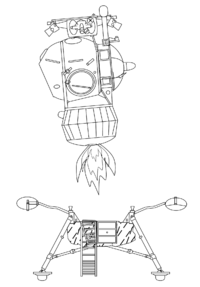Kosmos 379
Kosmos 379 (Russian: Космос 379 meaning Cosmos 379) was a test of the LK Lander (the Soviet counterpart of the Apollo LEM).
Mission
Earth orbit simulated propulsion system operations of a nominal lunar landing mission. Kosmos 379 entered a 192 to 232 km orbit. After three days fired its motor to simulate hover and touchdown on the moon, because of the burn in earth orbit the apogee increased to 1210 km. After a simulated stay on the Moon, it increased its speed by 1.5 km/s, simulating ascent to lunar orbit making the final apogee 14,035 km.
These main maneuvers were followed by a series of small adjustments simulating rendezvous and docking with the Soyuz 7K-L3. The LK Lander tested out without major problems and decayed from orbit on September 21, 1983.
Parameters
- Spacecraft: LK Lander
- Mass: 5500 kg
- Crew: None
- Launched: November 24, 1970
- Landed:Reentered September 21, 1983
- Orbit: 192 km
External links
|
|---|
|
Kosmos 318 | OPS 6531 | Intelsat III F-6 | Kosmos 319 | Kosmos 320 | Kosmos 321 | Kosmos 322 | ITOS-1 · Australis-OSCAR 5 | DS-P1-I No.6 | SERT-2 | E-8-5 No.405 | Kosmos 323 | Ōsumi | OPS 0054 | Molniya-1 No.17 | Kosmos 324 | Kosmos 325 | OPS 0440 · OPS 3402 | Wika · Mika | Kosmos 326 | Meteor No.14 | Kosmos 327 | NATO 2A | Kosmos 328 | Kosmos 329 | Kosmos 330 | Nimbus 4 · Topo-1 | Kosmos 331 | OPS 7033 · OPS 7044 | Kosmos 332 | Apollo 13 | Kosmos 333 | OPS 2863 | Intelsat III F-7 | Kosmos 334 | Dongfanghong I | Kosmos 335 | Kosmos 336 · Kosmos 337 · Kosmos 338 · Kosmos 339 · Kosmos 340 · Kosmos 341 · Kosmos 342 · Kosmos 343 | Meteor No.13 | Kosmos 344 | Kosmos 345 | OPS 4720 · OPS 8520 | DS-P1-Yu No.36 | Soyuz 9 | Kosmos 346 | STV-3 | Kosmos 347 | Kosmos 348 | Kosmos 349 | OPS 5346 | Meteor-M No.17 | OPS 6820 | Molniya-1 No.21 | Kosmos 350 | Kosmos 351 | Unnamed | Kosmos 352 | Kosmos 353 | Zenit-4 No.75 | OPS 4324 | Intelsat III F-8 | Kosmos 354 | Interkosmos 3 | Kosmos 355 | Kosmos 356 | Venera 7 | OPS 7874 | Skynet 1B | Kosmos 357 | Kosmos 358 | Kosmos 359 · Kosmos 359 | OPS 8329 | Transit O-19 | Kosmos 360 | OPS 7329 | Orba · X-2 | OPS 0203 | Kosmos 361 | Luna 16 | Kosmos 362 | Kosmos 363 | Kosmos 364 | MS-F1 | Kosmos 365 | Molniya-1 No.19 | Kosmos 366 | Kosmos 367 | Kosmos 368 · Nauka No.3 | Kosmos 369 | Kosmos 370 | Kosmos 371 | Interkosmos 4 | Meteor-M No.16 | Kosmos 372 | Kosmos 373 | Zond 8 | Kosmos 374 | OPS 7568 | Kosmos 375 | Kosmos 376 | OPS 5960 | OFO · RM-1 | Luna 17 ( Lunokhod 1) | Kosmos 377 | Kosmos 378 | OPS 4992 · OPS 6829 | Kosmos 379 | Kosmos 380 | Molniya-1 No.23 | OAO-B | Kosmos 381 | Kosmos 382 | Kosmos 383 | Kosmos 384 · Nauka No.2 | NOAA-1 · CEPI | Uhuru | Kosmos 385 | Peole | Kosmos 386 | Kosmos 387 | Kosmos 388 | Kosmos 389 | DS-P1-M No.1 | Molniya-1 No.22 |
|
Payloads are separated by bullets ( · ), launches by pipes ( | ). Manned flights are indicated in bold text. Uncatalogued launch failures are listed in italics. Payloads deployed from other spacecraft are denoted in (brackets). |

